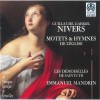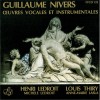Biography
Guillaume-Gabriel Nivers (ca 1632 – 13 November 1714) was a French organist, composer and theorist. His first livre d'orgue is the earliest surviving collection with traditional French organ school forms. Nivers's other music is less known; however, his treatises on Gregorian chant and basso continuo are still considered important sources on 17th century liturgical music and performance practice.
Nivers was born into a prosperous family: his father was farmer to the bishop. Nothing is known of his early years or his musical training except that he may have received a degree from the University of Paris. In the early 1650s Nivers became organist of Saint-Sulpice, a post he would retain until 1702. In 1668 the composer married; he had one son.
Nivers's subsequent career was quite illustrious. On 19 June 1678 he was chosen as one of the four organists of Chapelle Royale—an ensemble of musicians who performed sacred music for the king. The other three organists were Nicolas Lebègue, Jacques Thomelin and Jean Buterne. Nivers only resigned late in life, in 1708, and was succeeded by Louis Marchand. This prestigious post was followed by another in 1681, when the composer succeeded Henri Du Mont as master of music to the queen. Finally, in 1686 Nivers became in charge of the music at Maison Royale de Saint-Louis in Saint-Cyr-l'École—a convent school for young ladies who were poor but of noble birth. Nivers apparently had difficulties with the founder of the school, Madame de Maintenon, but retained the post until his death. His colleagues at St Cyr were Jean-Baptiste Moreau, who worked there since the school's inception, and possibly Louis-Nicolas Clérambault, who may have helped Nivers from c. 1710 until the latter's death in 1714. Clérambault succeeded Nivers both at St Sulpice and St Cyr.
During his lifetime, Nivers was highly regarded not only as organist and composer but also as a music theorist. His treatise on composition (Traité de la composition de musique, 1667) was well-known outside France and endured into the 18th century. His work in the field of Gregorian chant resulted in influential editions of liturgical music (including an edition of Missa cunctipotens genitor Deus, which most French organ composers used as a model for their mass settings) and helped the Catholic counter-reform.
Nivers composed several religious vocal works, and published three organ books (1665, 1667, 1675) containing more than 200 pieces. They include suites in all ancient (ecclesiastical) modes, a mass, hymns, and settings of the Deo Gratias and Te Deum. These books are the first collections of organ music to have been printed in France since Titelouze's. With his colleague and friend Lebègue, Nivers embodies the solo organ style which was subsequently represented - and adorned - by François Couperin and the short-lived Nicolas de Grigny. Several theoretical treatises by Nivers are preserved. They remain useful sources for knowledge of both musical theory and practice of his time.







![Great European Organs. 64-Daniel Roth [Saint-Sulpice, Paris]](http://static.classicalm.com/repository/collection-cover/small/967-img1342708833767081.jpg)

